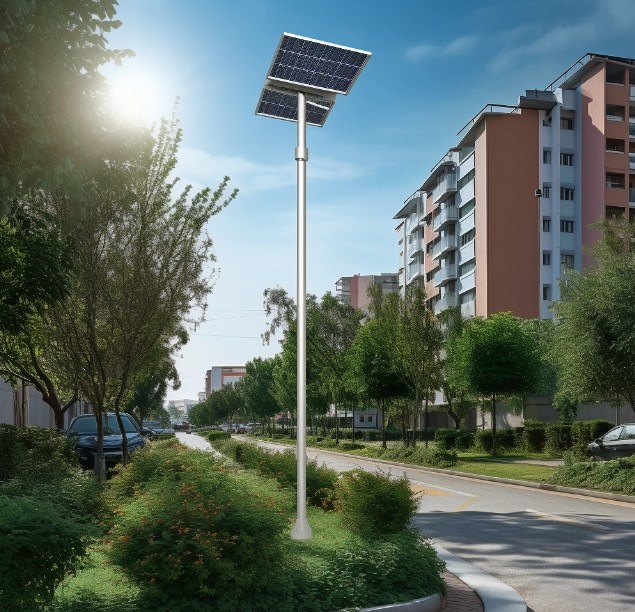A Guide to Solar Lighting Batteries for Sustainable IlluminationPosted by Stephen Shickadance in The Basics. Solar FAQs. Solar Lighting Design.Solar lighting has emerged as a beacon of sustainable technology, providing efficient and environmentally friendly solutions for both outdoor and indoor illumination. At the heart of these solar lighting systems lies a critical component - the battery. In this comprehensive guide, we will navigate the intricacies of solar lighting batteries, exploring their types, technologies, and key considerations for achieving lasting and sustainable illumination.
Understanding the BasicsTypes of Solar Lighting Batteries: Solar lighting systems commonly employ three main types of batteries: lithium-ion, nickel-metal hydride (NiMH), and lead-acid. Each type has unique characteristics that cater to different needs and applications. Solar lights operate by converting sunlight into electrical energy during the day and storing it in batteries for later use. The stored energy powers the lights during nighttime hours, offering an eco-friendly and cost-effective lighting solution. The Heart of Solar Lighting Systems: A Comparison of BatteriesSolar lighting systems have revolutionized outdoor and indoor illumination, offering an eco-friendly and energy-efficient alternative. At the core of these systems are batteries, crucial for storing solar-generated energy to power lights during the night. In this article, we delve into the comparison of batteries commonly used in solar lighting systems, shedding light on their features, advantages, and considerations. Lithium-ion BatteriesAdvantages:
Considerations:
Nickel-Metal Hydride (NiMH) BatteriesAdvantages:
Considerations:
Lead-Acid BatteriesAdvantages:
Considerations:
Choosing the Right Battery for Your Solar Lighting SystemCapacity:
Voltage:
Cycle Life:
Temperature Tolerance:
Choosing the Right BatteryLithium-ion vs. NiMH Batteries: Lithium-ion batteries are known for their high energy density, longer cycle life, and lower self-discharge rate. On the other hand, NiMH batteries are considered environmentally friendly and suitable for high-drain applications. The choice between the two depends on factors such as cost, performance requirements, and environmental considerations. Factors to Consider When Choosing Batteries: Capacity, voltage, cycle life, and temperature tolerance are crucial factors when selecting a battery for your solar lighting system. Understanding the specific requirements of your lighting setup will guide you in making the right choice. Maximizing Battery PerformanceProper Maintenance Practices: To extend the lifespan of your solar lighting batteries, regular maintenance is essential. This includes cleaning solar panels, checking connections, and ensuring proper ventilation for lead-acid batteries. Tips for Cold Weather Operation: Cold temperatures can affect battery performance. Implementing strategies such as insulation, using cold-resistant batteries, and adjusting the lighting system's settings can help overcome the challenges posed by winter weather. Eco-Friendly IlluminationThe Environmental Impact of Solar Lighting Batteries: Solar lighting, powered by rechargeable batteries, significantly reduces the carbon footprint associated with traditional grid-powered lighting systems. Understanding the recyclability of different battery types adds another layer of eco-friendliness to solar lighting solutions. Case Studies and Success StoriesReal-world Applications: Explore case studies highlighting successful applications of solar lighting batteries. From residential landscapes to commercial spaces, these examples showcase the versatility and effectiveness of solar lighting systems. Future InnovationsAdvancements in Solar Battery Technology: Stay informed about the latest innovations in solar battery technology. Ongoing research and development continue to enhance the efficiency and sustainability of solar lighting batteries, paving the way for even more eco-friendly illumination solutions. ConclusionIn the pursuit of sustainable illumination, solar lighting systems stand out as a beacon of innovation. Understanding the role of batteries in these systems is crucial for maximizing their efficiency and lifespan. By choosing the right battery, implementing proper maintenance practices, and staying abreast of technological advancements, you contribute not only to the longevity of your solar lighting setup but also to a greener and more sustainable future. Illuminate your surroundings responsibly, harnessing the power of the sun for enduring and eco-friendly lighting solutions.
The Basics
Solar FAQs
Solar Lighting Design
|
ArchivesNo Archives Categories
Want More Info? |
LATEST NEWS & ARTICLES

